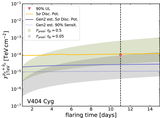Search for High-energy Neutrino Emission from Galactic X-Ray Binaries with IceCube
Abstract
We present the first comprehensive search for high-energy neutrino emission from high- and low-mass X-ray binaries conducted by IceCube. Galactic X-ray binaries are long-standing candidates for the source of Galactic hadronic cosmic rays and neutrinos. The compact object in these systems can be the site of cosmic-ray acceleration, and neutrinos can be produced by interactions of cosmic rays with radiation or gas, in the jet of a microquasar, in the stellar wind, or in the atmosphere of the companion star. We study X-ray binaries using 7.5 yr of IceCube data with three separate analyses. In the first, we search for periodic neutrino emission from 55 binaries in the Northern Sky with known orbital periods. In the second, the X-ray light curves of 102 binaries across the entire sky are used as templates to search for time-dependent neutrino emission. Finally, we search for time-integrated emission of neutrinos for a list of 4 notable binaries identified as microquasars. In the absence of a significant excess, we place upper limits on the neutrino flux for each hypothesis and compare our results with theoretical predictions for several binaries. In addition, we evaluate the sensitivity of the next generation neutrino telescope at the South Pole, IceCube-Gen2, and demonstrate its power to identify potential neutrino emission from these binary sources in the Galaxy.
- Publication:
-
The Astrophysical Journal
- Pub Date:
- May 2022
- DOI:
- 10.3847/2041-8213/ac67d8
- arXiv:
- arXiv:2202.11722
- Bibcode:
- 2022ApJ...930L..24A
- Keywords:
-
- Neutrino astronomy;
- Neutrino telescopes;
- X-ray binary stars;
- Galactic cosmic rays;
- 1100;
- 1105;
- 1811;
- 567;
- Astrophysics - High Energy Astrophysical Phenomena
- E-Print:
- 10+7 pages, 4 figures
